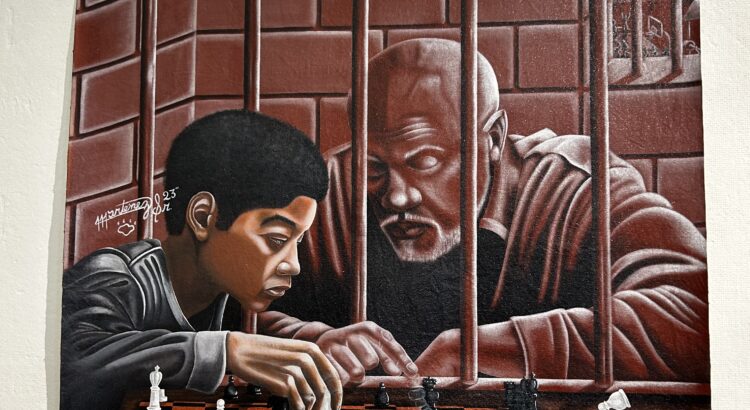[Title photo: Kings Gambit by Marte’nez Sr.; Acrylic]
The Prison Creative Arts Project (PCAP) is an initiative through the Residential College at The University of Michigan with a mission dedicated to bringing those impacted by the justice system to the U-M community for artistic collaboration, mutual learning, and growth. The program hosts a variety of workshops in visual art, theater, choral music, photography, and more. The Duderstadt Gallery is hosting an exhibition of a year-long collaboration with PCAP featuring art by incarcerated artists.
To produce the gallery, the PCAP community visited 24 adult prisons throughout the state of Michigan to handpick the selection of art being presented. During their visits, the volunteers review artwork and have the opportunity to discuss and exchange insights with artists, fostering a profound understanding of the intent behind each distinctive piece.
[30 Animal Granny Square Blanket by Douglas Bail]
The gallery intrigued me with the inherent individuality behind each piece. There were paintings, pencil drawings, sewn creations and figurines—and more! There was truly a collection of artistic mediums and untold stories.
[Boxed In by THE TEXAN; Acrylic, Canvas]
The gallery is open until April 3rd, and the hours of operation are listed below. Much of the art is for purchase at a variety of price ranges, from $35 to well over $500. There are many resources located at the gallery with ways to get involved with PCAP and other community and outreach groups in Michigan at the University and beyond. I left the gallery with the quote from the welcome guide ruminating through my mind:
“Art has truly saved my life. It has broght light in a place designed to keep us in the dark. It allows us to tell our story, or express how we feel not having to say a word. Art gives voivce to the voiceless…” —DaJuan
Gallery Hours:
Sun & Mon 12PM – 6PM
Tues – Sat 10AM – 8PM
More about PCAP here.
[Piano Jewelry Box with Drawer & Bench by Kimmy L. Emig; Wood]








